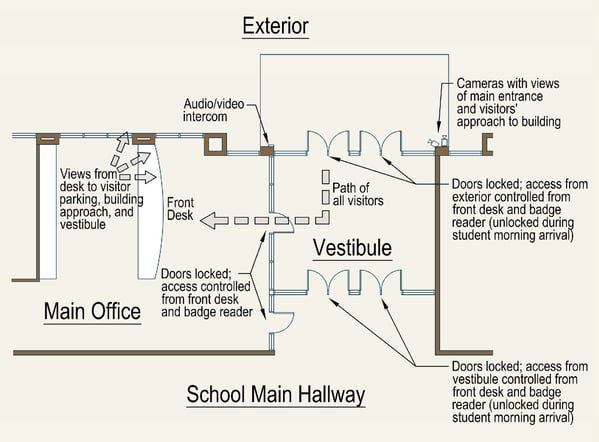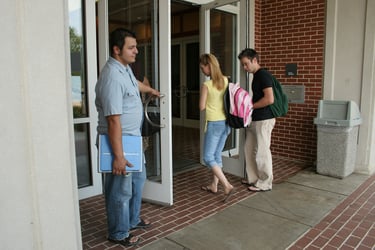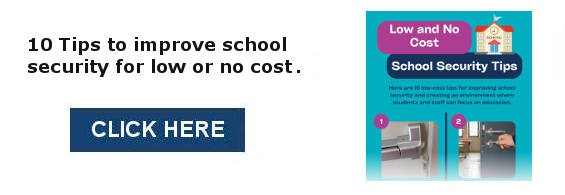The first safety measure generally observed by visitors at a school is the security vestibule at the front entrance of the school. Security vestibules provide administrators with control over who has access to the interior of the school, thus providing an important line of defense. Yet not all schools have this important feature, or don’t educate staff, students, and parents enough about its role, and I think it’s past time to change that.
What Exactly is a Vestibule, and How Does it Work?
 A vestibule is an enclosed area between the outside door of a building and the inside door. When a visitor arrives at the front door of a school, the doors to the interior are locked. As a best practice, the school will have an audio/visual intercom situated to the side of the exterior doors. When the buzzer is pressed, it alerts the main office that a visitor is outside. A staff member can use the audio/visual intercom to see the visitor’s face and to request a reason for the visit. Once their purpose is validated, the office staff can electronically unlock the exterior door, allowing the visitor to proceed into the vestibule.
A vestibule is an enclosed area between the outside door of a building and the inside door. When a visitor arrives at the front door of a school, the doors to the interior are locked. As a best practice, the school will have an audio/visual intercom situated to the side of the exterior doors. When the buzzer is pressed, it alerts the main office that a visitor is outside. A staff member can use the audio/visual intercom to see the visitor’s face and to request a reason for the visit. Once their purpose is validated, the office staff can electronically unlock the exterior door, allowing the visitor to proceed into the vestibule.
Once a person enters the vestibule, they are generally directed to check in at the main office. Schools that have an enclosed vestibule will have entry doors to the main area that are locked from the inside. This allows for egress from the school but does not allow for free access into the school. If the school does not have an enclosed vestibule, all entryways to the student areas of the school should be behind closed, locked doors. This controls what part of the school a visitor has immediate access to. Wayfinding signage should direct the visitor directly to the main office.
At this point, the visitor should be required to present their driver’s license or state identification card so the school can run a background check through a visitor management system. The visitor is then given a pass and a name badge that must be displayed during the entirety of their visit.
The vestibule also serves as a single point of entry for students who are late to school or returning to school after an appointment. This helps administrators keep track of who is coming and going and underscores the importance of a single point of entry - and exit - at the school. It is important that all students be accounted for during the school day.
The Importance of the Vestibule is Being Noticed
According to The School Survey on Crime and Safety (SSOCS), 97.1% of schools surveyed reported that they use some form of controlled access to the building during school hours. But not all schools have a vestibule, and not all vestibules are properly secured or managed. Many large school districts across the country are pushing for the installation of vestibules throughout their districts.
In the days following the tragedy at Robb Elementary School in Uvalde, Texas, the school board in Virginia’s largest school system pushed the superintendent to prioritize the construction of a security vestibule at every school in its district. While many may be concerned by the price tag on vestibule construction - approximately $15 million in this instance - we need to remember that there can be no price put on the safety of our children.
Additional Security Factors that Enhance the Vestibule’s Effectiveness
Not all crime is preventable, and one level of protection does not guarantee safety and security in and of itself. The vestibule as a security measure works hand in hand with many other means of security. Below are six additional security measures that must be in place to enhance the effectiveness of the vestibule.
- Quality security cameras - In addition to the audio/visual intercom outside the main exterior doors, the school should invest in quality security cameras that are ideally placed around the campus. A best practice is to have camera coverage at the entrance of the school property, in the parking lot, and at the entrance of the school facing away from the building. These placements allow for thorough visuals of the vehicles entering school grounds, as well as any visitors approaching the school. Staff should be able to see that a visitor is approaching before the visitor reaches the front door.
- Policies and procedures - Staff should be provided with written policies and procedures describing how the security vestibule is to be operated and the expectations of all employees when encountering an individual at the school’s entrance. Teachers and administration should be instructed to never prop open any exterior door or interior lobby door leading to the student areas of the school. Front office staff who are in control of the vestibule doors should be trained on when visitors should be allowed entry, and what to do if there is a concern. In an incident that happened at a nearby high school, a student from another school approached the vestibule and presented the staff member with a fraudulent student ID number. The office staff member was trained in how to identify students by their ID number. She followed the policy and denied the student entry to the building.
- Educate students and parents - In addition to staff education, it is important to educate students and their families on proper use of the vestibule. Students need to understand that they should not open any doors for any visitors. In the instance described above, after the student was denied entry at the main entrance by the office staff member, this student proceeded to another exterior door and, after knocking, was allowed entry by another student. The student who allowed entry did not understand the risks of doing so. This needs to be thoroughly communicated to students on a regular basis.
Parents or other visitors also need to understand that they should not hold the door open for anyone who may be accessing the building behind them, no matter how legitimate their purpose may seem. All visitors approaching the school should be screened individually. These expectations can be communicated through security training within the school and via e-mails and newsletters sent to parents and guardians.

- Lock all exterior doors - A maintenance routine should be in place to check all exterior doors daily to ensure that they latch and lock properly. Maintenance personnel should adjust doors or door closers that are not functioning properly, and door closers should be repaired or replaced as needed. Exterior doors that do not shut and lock during school hours are a top security risk. Someone with ill intentions could bypass the security at the front entrance and attempt entry through a secondary exterior door. Even a visitor with good intentions should have only one point of access into the building: the main entrance.
- Lock all interior doors – Schools that do not have an enclosed vestibule generally have an open area at the front of the school, such as a lobby and seating area. The main office is commonly located inside this lobby. Doors leading to different wings of the school may also be located inside the lobby, with access allowed for teachers and their students. Some schools even have special use spaces, such as an auditorium, directly off the main lobby. Any doors that lead into an area of student traffic or a place students gather, such as hallways, cafeterias, media centers, and auditoriums, should be closed and locked at all times. These doors should have electronic card reader access for employees and should only be unlocked for visitors after the visitor checks in with the main office.
- Secondary security post – If the school has a school security officer or school resource officer within their building, a check-in station should be present in the entrance lobby or near the enclosed vestibule. During times of high traffic, an officer should be present at this station to validate the purpose of any visits. Throughout the rest of the day, when a visitor makes entry into the vestibule or lobby area, an officer or designated staff member would be alerted to their presence. There are also times when the visit could be handled without the visitor making complete entry into the school, such as when a parent is dropping off a forgotten lunch.
It can’t be said enough - security planning and implementation is crucial to keeping our children safe while in school. Security vestibules provide a critical element of protection, but it takes the entire community to ensure that they are not compromised. When all of our security resources, both human and mechanical, work together as intended, we as parents can rest assured that our most precious assets are focused, learning, and safe in a healthy educational environment.



.png)

-1.jpg)
.jpg)
.jpg)
.jpg)
-2.jpg)
.jpg)


.jpg)
.jpg)
.jpg)
.jpg)
.jpg)

